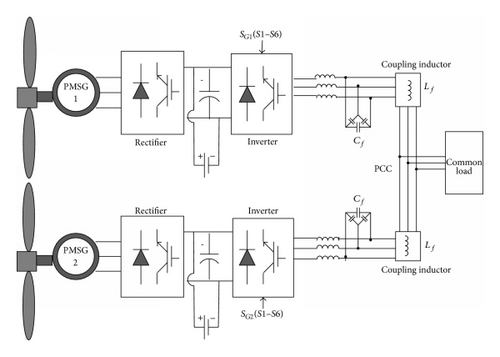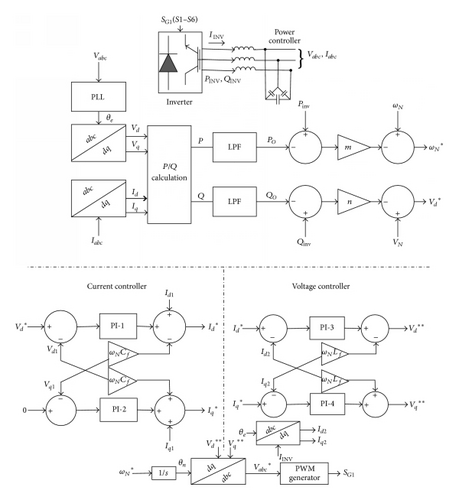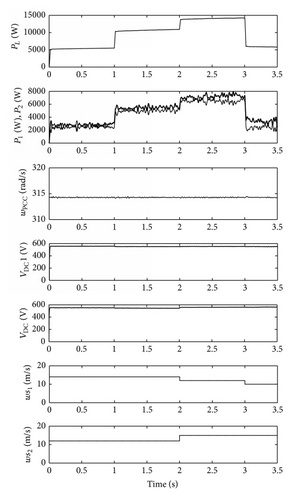Load Sharing of Wind Based Microgrid in Autonomous Operation
Abstract
Autonomous wind energy conversion systems sharing a common load consist of a number of voltage source converters operating in parallel. A suitable control system should ensure desired load sharing among these as a number of these sources operating in parallel are required to meet the load demand and load excursions should not lead to instability of the system. In absence of the grid there is no reference angle for synchronization. Hence, a control scheme for parallel-connected three-phase converters incorporating the desirable features needs to be developed in order to exploit the renewable energy sources, which are intermittent in nature as effectively as possible in case of an autonomous microgrid. A simple and effective droop control strategy without the use of conventional αβ technique incorporating only dq components has been proposed for load sharing among wind energy conversion systems connected by back to back voltage source converters in autonomous operation. The need for communication link should also be avoided, hence reducing the system cost. The system is modelled using Matlab and the control is authenticated by simulation results.
1. Introduction
Due to increased penetration of renewable energy sources, particularly wind, the number of DG (distributed generator) units operating autonomously is on the rise. Islanded microgrids can find application in remote places where main grid is unavailable. In this configuration, the microgrid elements are responsible for voltage and power control. The microgrid consisting of supply, load, and storage is a fully controlled entity. A single autonomous unit is of low power capacity; hence operation of a cluster of DGs is responsible for feeding the load. Maintaining the balance of power in autonomous mode requires the participation of all DGs, and this has attracted the attention of several researchers. The DGs in a microgrid, which is operated in islanding mode, should share power between each other in an appropriate ratio to prevent circulating current and thermally overstressing or damaging of components [1].
In the conventional electrical network with synchronous generator, any alteration in active power balance causes change in synchronous frequency. Load frequency control is achieved by the active power regulation of the synchronous generators. In absence of a synchronous generator, this conventional method cannot work. In this situation, in absence of a regular grid, there are two methods to control voltage source converter- (VSC-) based microgrids. A well-planned coordinated control is required to utilize these resources efficiently. The first control technique employs communication links such as the master-slave approach which are used for microsources operating within a particular area. In the second case, power sharing is achieved by the real power-frequency droop (P-ω) control and the reactive power-voltage droop (Q-V) droop control in the droop-controlled renewable power system [1–3]. The elimination of communication link makes the generation truly distributive in nature and considerably reduces the cost of the system. The P-ω droop control can achieve accurate real power sharing results while the Q-V droop control helps to achieve better proportional sharing of reactive power [4–6]. Droop controllers are adopted in autonomously operated systems. The droop control uses the real power out of a generator to calculate the ideal operating frequency. This relaxing of a stiff frequency allows the microgrid to dampen the fast effects of changing loads, increasing the stability of the system. Droop power systems can be connected to highly intermittent supply like wind based energy sources [7–10]. The avoidance of communication link makes it a reliable and highly competitive option.
This paper proposes coordinated load sharing among two PMSG (permanent magnet synchronous generator) based wind driven distributed generators sharing a common load in autonomous operation without using the traditional αβ transformation. Only dq components are used for control. Hence, the control scheme is simple yet effective. In most droop control systems the source is dynamically modelled or the DC voltage is assumed to be fixed [11]. The system uses two PMSG based WECS for analysis of results. Moreover, load perturbations lead to a change in DC link voltage affecting the PCC (point of common coupling) voltage. Fast-response energy storage module (BESS) has been included in each WECS to provide a constant DC voltage. This method can also be further applied to many VSC connected generators feeding a common load. This paper is organized as follows. In Section 2, the microgrid components are explained briefly. The control designs of the droop based power controller and voltage and current control controller are presented in Section 3. Section 4 presents the simulation results and related discussion of the paralleled two 15 kW inverter system. Finally, Section 5 concludes this paper.
2. Microgrid Components
The major components of each VSC-based microgrid are the VSCs, generators, output filter and coupling inductance, DC bus, and battery and load. The schematic of the proposed system is shown in Figure 1. The DG in this case is 15 kW PMSG based WECS (wind energy conversion system). The output voltage of each inverter is related to DC voltage by modulation index (MI).

However, if DC voltage reduces drastically so that the MI becomes greater than the inverter MIMAX, it cannot supply the reference voltage. Reference [6] demonstrates the fact that when the DC voltage is fixed, the switching process can be neglected and the inverter produces the reference voltage. In this condition, the dynamics of primary source has no effect on VSC output voltage. Hence, a fast-response BESS (battery energy storage system) is integrated at the DC link of each VSC-based DG with the help of a buck-boost converter to overcome the voltage fluctuations due to the intermittent wind conditions.
3. Autonomous Inverter Controller
This model consists of power sharing controller, the voltage controller, and current controller. Figure 2 shows the control of the autonomous inverter controller. The voltage and current controller can track the voltage references produced by the droop controller. Adjustment of droop coefficients is necessary as effective power sharing cannot be achieved, at the expense of degrading the voltage regulation [12]. The control scheme of the one of the autonomous generator is detailed in the present section.

3.1. Power Sharing Controller
3.2. Voltage Controller
3.3. Current Controller
In the inner current loop, Id2 and Iq2 are obtained by the abc to dq transformation of Iinv (inverter current).
The quadrature axis reference voltage is set to zero; in (6) the difference between the obtained reference current of the current controller and is compared to Id2 and Iq2 obtained by the abc to dq transformation of Iinv (inverter current).
4. Simulation Study
Figures 3, 4, 5, and 6 show the simulation results with the proposed control scheme using the Matlab/Simulink software. In Figure 3, the simulation results of equal active power sharing of the two WECS between the intervals of 1 sec to 3 seconds are shown. The DC voltages are almost fixed during simulation and the MI remains in allowable range since the battery storage system has rapid dynamics. The constraints of voltage and frequency have to be adhered along with power sharing; hence an appropriate value of coefficients m and n is chosen. A total load of 18 kW (PL) is shared equally by both wind generators. The voltage magnitude at the PCC (VPCC) is balanced. The current waveform of VSCs (IINV1 and IINV2) is shown along with load current (Il) between the intervals 1 sec to 1.5 sec for active equal power sharing. The load current of 38 A is shared almost equally by the two DGs. The frequency at PCC (WPCC) and the frequency of the two DGs (W1 and W2) are also shown.




Figure 4 shows the result for equal active and reactive load sharing. The results for reactive power sharing validate the fact that the load of 10 KVAR (QL) is shared equally by both the WECS (Q1 and Q2, resp.) as is the active power (P1 and P2).
In Figure 5, the frequency droop gain for first generator is set to m1 and the droop gain of the second generator is set to m2. The frequency droop gain of one WECS is set more than the other. The load of 12 kW is shared of which 5 kW is supplied by first wind generator whereas 7 kW is supplied by second wind generator. The voltage waveforms and frequency at PCC are also shown for m1 ≠ m2 between the intervals of 1 sec to 3 sec. Load is shared as per requirement by varying the droop gain.
The system is studied for varying wind and load conditions in Figure 6. Initially a common load of 6 kW was shared by both the generators with equal frequency droop coefficient, hence effecting equal load sharing as explained in Section 2. The load demand increment is shared between both the AC sources perfectly as validated by simulation results for a period of 3.5 sec. At t = 1 sec, the load is increased by 6 kW by switching on the CB (circuit breaker), generation output of first AC generator (P1) and output of second AC generator (P2) increase to compensate the increased load demand, and system frequency at the point of common coupling (wpcc) remains constant at the desired frequency of 50 Hz. At t = 2 sec, the load is increased by 4 kW which is compensated by both the generators.
At t = 3 sec, the additional loads of 6 kW and 4 kW are removed by switching off the CBs and the generation is curtailed for both the AC sources accordingly. VDC1 and VDC represent the DC link voltage of the two parallel converters of the AC subgrid. The respective wind speed inputs of the wind turbines are shown as ws1 and ws2 in the figure. The wind speed input is varied from 10 m/s to 15 m/s in steps for both wind turbine generators but the intermittent wind conditions do not affect the system performance under varying wind condition due to BESS interfaced at the DC link. Hence, the implemented droop-controlled system is stable for a cluster of distributed AC resources sharing a common load using parallel back to back converters.
5. Conclusion
With increased penetration of the renewable energy sources power curtailing has to be resorted in order to ensure requisite load sharing between microsources. A simple and viable control strategy without the conventional αβ technique has been validated for load sharing among WECS connected by back to back VSCs in autonomous operation. The proposed system shows a good voltage regulation and a stable response when subjected to load transients as well as wind speed variations which is validated by Matlab simulations.
Conflict of Interests
The authors declare that there is no conflict of interests regarding the publication of this paper.
Appendix
See Table 1.
| Parameters | Inverter 1 | Inverter 2 |
|---|---|---|
| Frequency droop coefficient, m | 3 × 10−5 | 3 × 10−5 |
| Amplitude droop coefficient, n | 8 × 10−3 | 8 × 10−3 |
| DC link voltage | 500 V | 500 V |
| Filter inductance | 2 mH | 2 mH |
| Filter capacitance | 11 μF | 11 μF |




